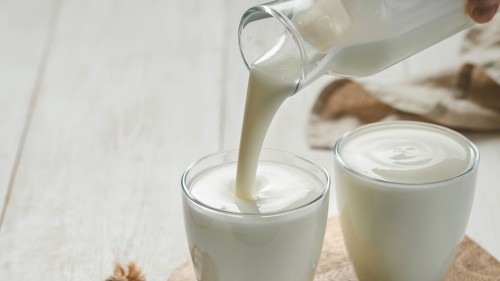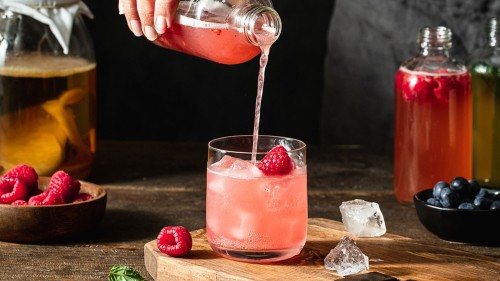The 9 Best Fermented Foods and Drinks for Your Digestive Health
Last Updated on February 13, 2024
Dietitian Reviewed Ana Reisdorf, MS, RD
Fermented foods have been eaten for centuries in cultures around the world. Here is a list of the best-studied fermented foods and drinks that may offer digestive benefits, along with tips to help you find and use them


Key Highlights
- While the hype around probiotics is relatively new, the truth is that humans have been eating them for thousands of years in the form of fermented foods and drinks.
- Regularly eating fermented foods like yogurt, kefir, and kimchi provides probiotics that populate your gut with beneficial bacteria to improve digestion and gut health.
- The process of fermentation uses microorganisms to transform foods. This gives the foods their tangy, sour taste and allows the microbes to continue living in them.
- It’s important to pair probiotic foods with prebiotic foods like whole grains, beans, and certain fruits and vegetables. Prebiotics help feed the probiotics, allowing them to thrive and proliferate in your gut.
A Word on Fermentation
Fermentation is the process of exposing foods to harmless microorganisms, which cause chemical changes.
These changes result in a very different tasting food or drink, which often continues to house those living organisms.
Research shows that sometimes those microbes benefit us when we finally eat the fermented product. If a microbe has been proven beneficial to us, we can accurately call these fermented foods probiotics.
Most cultures have some variety of fermented food embedded in their history, made from foods common to their areas, like soybeans, tea, milk, cabbage, or other vegetables.
1. Yogurt
Let’s start with the ever-popular dairy food, yogurt. Most Americans are familiar with this creamy, milk-based snack, which comes in a large variety of flavors.
Many kinds of bacteria can ferment yogurt, but it is most known for the probiotic bacterium, Lactobacillus bulgaricus. This microbe has been shown to ward off harmful bacteria from our digestive system. (1)
Streptococcus thermophilus is another microbe commonly used to ferment milk into yogurt. (2)
This bacterium is used in many probiotic supplements because of its effectiveness against diarrhea, constipation, and irritable bowel syndrome symptoms.
S. thermophilus also aids in lactose digestion. This makes it the perfect bacteria to accompany a dairy-based food, allowing those with lactose intolerance to enjoy it.
If constipation is an issue, yogurt may be helpful because S. thermophilus has been shown to help increase stool frequency and improve consistency. (3)
Actionable Steps
- Look for yogurt brands that advertise active and live cultures on the label to ensure you’re getting probiotic yogurt.
- The longer the list of microbes on the label, the more benefit you may get from the product.
- To get the most nutritional benefit, choose plain yogurt without added sugar, and consider Greek varieties for extra protein.
- You can mix a favorite fruit with your yogurt to liven it up.
2. Miso
Miso, a traditional Japanese paste made from fermented soybeans, may have originated from China. Miso has a pleasantly salty and umami flavor, which goes well with savory dishes.
The fungus Aspergillus oryzae is the organism responsible for miso’s fermentation process. (4)
Miso can be considered both a probiotic and prebiotic food because Aspergillus oryzae has been shown to feed the bacteria called Blauta coccoides, a microorganism that is being studied for digestive health as well as other possible health benefits. (5)
Blauta species are common in a healthy digestive system. They help us digest fiber and make special short-chain fatty acids (SCFAs). (6)
SCFAs are important in digestive health because they help strengthen the gut barrier, reduce inflammation in the gut, and even help protect against colon cancer.
Actionable Steps
- Fresh miso paste may be hard to find at most common grocery stores in the United States. Your best bet is to look for it in a refrigerated section in your nearest Asian market.
- There are endless ways to use miso, but it’s commonly added to soups or stir fry dishes in the United States.
- Be sure to add it at the end to avoid exposing the microbes to destructive high temperatures during cooking.
3. Sauerkraut
Sauerkraut fermented food is made from cabbage and has a strong, tangy taste. While some may consider sauerkraut a German food, it likely originated in China.
Like many other fermented foods, the microbe strains in sauerkraut vary.
Researchers have noticed that sauerkraut commonly hosts the lactic acid bacteria Leuconostoc mensenteroides, Lactobacillus brevis, and Lactobacillus plantarum. (7, 8, 9, 10)
These bacteria help protect the gut by fighting harmful bacteria. In some research, L. plantarum has been shown to help with constipation problems. (3)
One study found that sauerkraut improved symptoms for irritable bowel syndrome patients. The researchers attributed the improvement to the lactic acid bacteria. (11)
Cabbage, also known as a prebiotic, can improve overall digestive health. This is because prebiotics feed beneficial bacteria in our digestive system. (12)
What to Consider
- While sauerkraut can be found in most grocery stores, only the kind found in the refrigerated section will host live probiotic bacteria. Shelf-stable varieties have been pasteurized, which kills off the probiotics.
- Sauerkraut has a strong taste that some people may need to get used to. Start by adding it to morning favorites like avocado toast or scrambled eggs. Eventually, you may enjoy it as a side dish on its own.
4. Kefir
Kefir is a thick, sour-tasting drink made from fermented goat, sheep, or cow’s milk.
Kefir is one of the best-researched fermented foods. Kefir’s microorganism content sometimes includes over 50 different microbes and generally includes several species of Lactobacillus.
A review of studies highlighted kefir’s ability to fight foodborne bacteria like E. Coli and Salmonella, protecting our digestive system. (13)
What to Consider
- Many people make their own kefir, but it can be found in the dairy aisle of most major grocery stores, near the yogurt section.
- Many brands advertise active cultures on their labels and list which ones they contain.
- Choose plain kefir to avoid added sugar.
- Many people drink kefir just like it comes from the bottle. Some people prefer to add juice to sweeten it, while others blend it in a smoothie with their favorite frozen fruit.
5. Natto
Natto is a fermented soybean food known for its slimy texture, funky smell, and salty taste. It’s credited for housing the probiotic bacteria called Bacillus subtilis, a special bacterium with probiotic superpowers. (14)
It helps keep our digestive system healthy by making a sort of shield, which it shares with other probiotic bacteria. The bacteria can then unite and fight against bad bacteria in the gut, like Staphylococcus aureus.
What to Consider
- Natto is not easily found in American grocery stores yet. Your best bet is to look for it at your nearest Asian market, near the tofu section.
- Natto is an acquired taste, and Japanese people traditionally eat it at breakfast.
- It may be served by itself, on top of rice or pasta, or is sometimes topped with other foods like eggs or green onions.
6. Kombucha
Kombucha is a fizzy, tart, fermented tea drink. If you want to try kombucha, be aware that many varieties contain alcohol, although it’s usually in very small amounts.
Some research involving animals has shown that kombucha helped study subjects fight non-alcoholic fatty liver disease. (15)
This was achieved by changing the animals’ gut microbiome. More research is needed to see if this can work on humans.
How to Drink It
- Kombucha can be found in the refrigerated drink aisle of major grocery stores.
- Enjoy it cold right from the bottle, like seltzer water.
7. Pickles
Yes, pickles can be a fermented food, too. However, not all pickles are alike.
The kind that contains beneficial microbes is made slowly in a saltwater brine instead of the shelf-stable kind made with vinegar. This makes their taste and texture a bit different.
Fermented pickles generally contain several species of lactic acid bacteria (LABs), which survive the high salt content of the brine. (16)
LABs are known for their therapeutic properties in the digestive system. They aid with the digestion of food (including lactose), protect against foodborne bacteria, and may even help ward off cancer. (17)
Put It Into Action
- Pickles offering probiotic benefits will be found on the refrigerated shelves of the grocery store, generally in the produce section.
- Watch out for vinegar on the label, which means the pickles aren’t fermented.
- Enjoy fermented pickles any way you normally would. Eat them in sandwiches, tuna or potato salads, or as a tasty snack by themselves.
8. Kimchi
Kimchi is another food that uses cabbage and lactic acid bacteria, known as Leuconostoc mesenteroides, in its fermentation process.
The food is thought to have originated from Korea and uses other vegetables (like radishes and garlic), which intensifies its flavor.
Kimchi may improve the gut microbiome of those who suffer from obesity. However, the 2020 study showing this evidence was performed on mice; therefore, more human studies are needed. (18)
Put It Into Action
- Kimchi can be a rare find in American grocery stores, but it is sometimes found along with refrigerated pickles in the produce section. Otherwise, look for it in your closest Asian market.
- Many people enjoy kimchi on rice or in pasta. Its strong flavor can also add tang to your morning egg dishes.
9. Crème Fraiche
Let’s top it off with dessert.
Crème Fraiche generally has two main ingredients — cream and the fermenting bacteria Lactococcus lactis. Sugar is sometimes added to the tangy, sour cream product and used as a dessert topping.
L. lactis has been shown to help treat colitis in animal studies. It seems to work by reducing inflammation in the gut. (19)
Put It Into Action
- While this product is not popular everywhere in the United States, you may be able to find it near the traditional sour cream.
- Use crème fraiche in savory soups or mix it with sugar and put it on fruit or scones as a dessert treat.
Pairing Fermented Foods with Prebiotic Foods
Digestive health can’t exist on probiotic foods alone.
While fermented foods can help keep your digestive system feeling its best, the probiotics in the foods won’t survive without their own food to eat. This is where prebiotic foods come in.
Prebiotic foods are high-fiber foods we can eat that have been shown to help the friendly microbes in your gut thrive. These foods include:
- Vegetables (like onions, Jerusalem artichoke, asparagus, and chicory root)
- Fruits (like apples and bananas)
- Legumes (like beans)
- Whole Grains (like whole wheat, rye, and barley)
Frequently Asked Questions
Are probiotic foods better than supplements?
From a nutritional point of view, the answer to this question is yes. Probiotic foods offer nutrients like protein, carbohydrates, vitamins, and minerals that supplement pills don’t contain.
For example, kefir offers many of the same benefits that a glass of milk would. One glass is a good source of protein, calcium, and potassium.
Foods are also regulated by the FDA, whereas probiotic supplements are only regulated if they cause adverse reactions. This means you’ll have a better chance of getting what you pay for with probiotic food.
Besides improved digestion, what are some other benefits of fermented foods?
While their digestion-improving properties are becoming well known, the probiotics found in fermented foods are also being studied for other health benefits.
Researchers are discovering connections between a healthy microbiome and brain health, heart health, immune system health, and cancer prevention.
While the evidence is gaining ground, solid recommendations are difficult to make because of study inconsistencies.
The best news is that there’s nothing to be lost by eating your favorite probiotic foods since they generally offer solid nutrition in addition to the probiotic microbes.
How can I be sure a fermented food is helping my digestive system?
Unless you’re suffering from uncomfortable digestive symptoms like constipation, you likely won’t notice the subtle differences that come from eating fermented foods.
Just like adding any other healthy food to your diet, the benefits are gained over your lifetime of consistency, not instantly.
Are fermented foods safe?
Most fermented foods are safe for most people throughout their lifespan if they have been safely handled.
Many fermented foods are ancient recipes, and the bacteria used to ferment the foods have been consumed by humans for centuries.
Some fermented foods, like beer and wine, are not safe to consume during pregnancy because of their alcohol content.
Many fermented foods are made from high allergen foods like milk and soybeans. If you have a food allergy, be sure to read the labels carefully.
The Bottom Line
Humans have eaten and reaped the digestive benefits of fermented foods for thousands of years.
Fermentation is the process of adding microorganisms to foods like beans, tea, vegetables, or milk and allowing a chemical change to happen before consuming the new product.
Recent interest in probiotics and their benefits to humans has sparked the popularity of cultural fermented foods from around the world. Many are now readily available at local American grocery stores.
While you may not initially enjoy some fermented foods' stronger flavors and unique textures, the digestive benefits may encourage you to give them a try.
At WellnessVerge, we only use reputable sources, including peer-reviewed medical journals and well-respected academic institutions.
- Lactobacillus delbrueckii subsp. bulgaricus KLDS 1.0207 Exerts Antimicrobial and Cytotoxic Effects in vitro and Improves Blood Biochemical Parameters in vivo Against Notable Foodborne Pathogens:
https://www.ncbi.nlm.nih.gov/pmc/articles/PMC7541842/ - What is Probiotic S. Thermophilus?:
https://probiotics.org/s-thermophilus/ - Gut Microbiota and Chronic Constipation: A Review and Update:
https://www.ncbi.nlm.nih.gov/pmc/articles/PMC6379309/ - Japanese Traditional Miso and Koji Making:
https://www.ncbi.nlm.nih.gov/pmc/articles/PMC8307815/ - Japanese traditional dietary fungus koji Aspergillus oryzae functions as a prebiotic for Blautia coccoides through glycosylceramide: Japanese dietary fungus koji is a new prebiotic:
https://www.ncbi.nlm.nih.gov/pmc/articles/PMC4980852/ - The Role of Short-Chain Fatty Acids From Gut Microbiota in Gut-Brain Communication:
https://www.frontiersin.org/articles/10.3389/fendo.2020.00025/full - DNA Fingerprinting of Lactic Acid Bacteria in Sauerkraut Fermentations:
https://www.ncbi.nlm.nih.gov/pmc/articles/PMC2168044/#:~:text=Historically%2C%20four%20species%20of%20lactic,Pediococcus%20pentosaceus%2C%20and%20Lactobacillus%20plantarum. - Leuconostoc mesenteroides - From Beneficial Bacteria to Probiotic:
https://www.powerofprobiotics.com/Leuconostoc-mesenteroides.html#:~:text=mesenteroides%20NTM048%20isolated%20from%20green,like%20pathogenic%20bacteria%20and%20viruses. - Probiotic Properties of Lactobacillus brevis KU200019 and Synergistic Activity with Fructooligosaccharides in Antagonistic Activity against Foodborne Pathogens:
https://www.ncbi.nlm.nih.gov/pmc/articles/PMC7057033/ - Lactobacillus plantarum with Functional Properties: An Approach to Increase Safety and Shelf-Life of Fermented Foods:
https://www.ncbi.nlm.nih.gov/pmc/articles/PMC5994577/ - Lacto-fermented sauerkraut improves symptoms in IBS patients independent of product pasteurisation - a pilot study:
https://pubmed.ncbi.nlm.nih.gov/30256365/ - Gut Insight: Prebiotic Foods Sources:
http://www.gutinsight.com/prebiotic_food_sources_list.html - Microbiological, technological and therapeutic properties of kefir: a natural probiotic beverage:
https://www.ncbi.nlm.nih.gov/pmc/articles/PMC3833126/ - Probiotic Bifunctionality of Bacillus subtilis—Rescuing Lactic Acid Bacteria from Desiccation and Antagonizing Pathogenic Staphylococcus aureus:
https://www.ncbi.nlm.nih.gov/pmc/articles/PMC6843919/ - Effect of Kombucha on gut-microbiota in mouse having non-alcoholic fatty liver disease:
https://pubmed.ncbi.nlm.nih.gov/30815318/ - Traditionally fermented pickles: How the microbial diversity associated with their nutritional and health benefits?:
https://www.sciencedirect.com/science/article/pii/S175646462030195X#b0435 - Health and nutritional benefits from lactic acid bacteria:
https://pubmed.ncbi.nlm.nih.gov/2271223/ - Intervention with kimchi microbial community ameliorates obesity by regulating gut microbiota:
https://pubmed.ncbi.nlm.nih.gov/32876915/ - Lactococcus lactis subsp. cremoris FC alleviates symptoms of colitis induced by dextran sulfate sodium in mice:
https://pubmed.ncbi.nlm.nih.gov/19733697/





